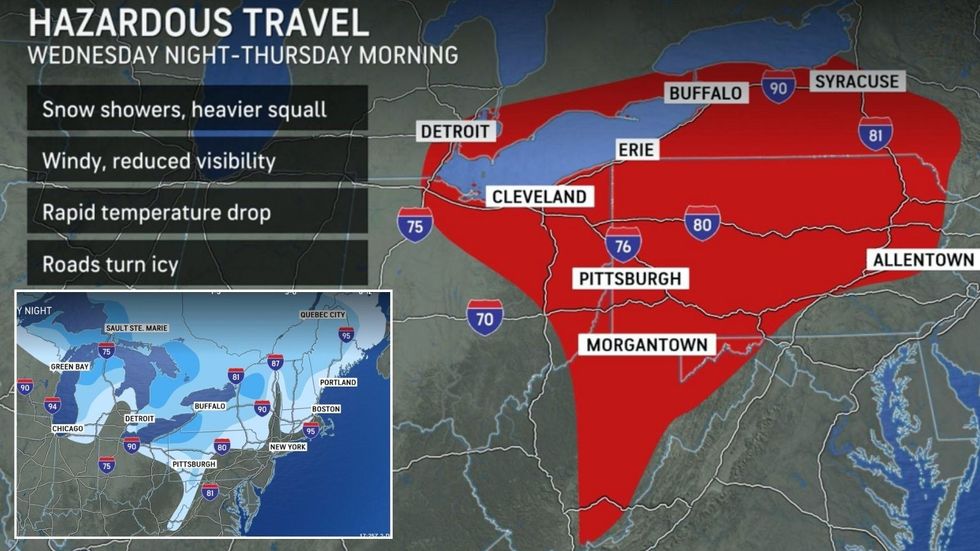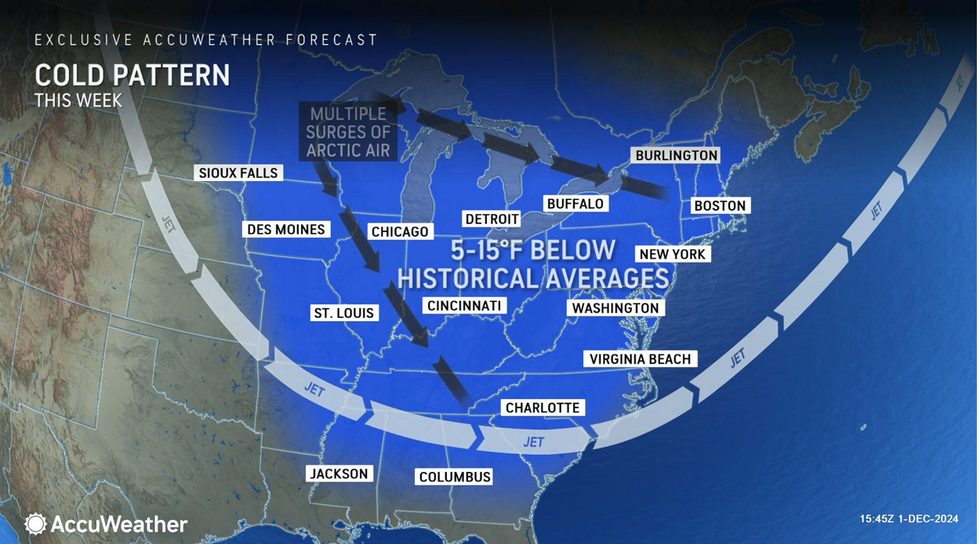A powerful ‘clipper’ storm loaded with a ‘direct Arctic discharge’ will plough snow-hit America threatening a ‘life-threatening emergency’.
As the winter blanket piles feet deep across eastern states, warnings are in force for another polar deluge.
Frenzied ‘snow squalls’ threaten travel mayhem as the United States is hit by one of its worst early season snowstorms.
A freezing plume sweeping from the North Pole will thrust temperatures 20 degrees below average for the time of year, experts warn.

A powerful ‘clipper’ storm loaded with a ‘direct Arctic discharge’ will plough snow-hit America threatening a ‘life-threatening emergency’
AccuWeather
AccuWeather meteorologist Bernie Rayno said: “This is a direct discharge of Arctic air, and we’re concerned about the potential for travel problems Wednesday night and Thursday morning.
“The coldest air of the season so far is expected to spread across the Northeast with gusty winds, rounds of snow and snow squalls that could create dangerous travel conditions.
“It will get cold enough in parts of the Southeast with a penetrating breeze to be a concern for water pipes bursting in poorly insulated areas of homes and businesses.”
Heavy snow in across the east is being driven by cold air from the north passing over warm waters of the Great Lakes.
The so-called ‘Lake effect’ can unleash some of the heaviest snow in the world pumped out in intense ‘snow bands’.
An unusually strong storm passing the lakes mid-week will drive blizzards as inches of snow falls by the hour.
AccuWeather meteorologist Jon Porter said: “A full-fledged blizzard could occur in areas downwind of the Great Lakes, including parts of the Buffalo and Cleveland metro areas, with snow falling at two inches or more per hour.

Frenzied ‘snow squalls’ threaten travel mayhem as the United States is hit by one of its worst early season snowstorms
AccuWeather
“Complete whiteouts are possible with winds gusting to 50 mph or even higher. Lake-effect snow bands can also be narrow, sometimes only three to five miles wide, where the intense snow is focused.
“Within any of these heavy snow bands, should a traveller become stranded, the situation can quickly escalate to a life-threatening emergency.”
The US National Weather Service warned a ‘clipper storm’ – a particularly strong winter storm from Canada also called an ‘Alberta Clipper’ – will drive snowfall.
Temperatures across the southern Appalachians and southeast will nosedive around 20F lower than normal, it warned.
A spokesman said: “A strengthening clipper storm will track north of the Great Lakes from midweek with a widespread snow and gusty to strong winds through the region and into the Northeast U.S. followed by the potential for more lake effect snow.
“A reinforcing shot of Arctic air will arrive behind a strong cold front, and this will gradually reload the prospects for new rounds of lake-effect snow later in the week downwind of the Great Lakes.”

A freezing plume sweeping from the North Pole will thrust temperatures 20 degrees below average for the time of year, experts warn
AccuWeather
Lake-effect snow has become more of a hazard than usual this year with the Lakes warmer than they should be for early winter.
An unexpected storm thrown into the mix will drive blizzards and deep snow drifts through the week.
Weather Channel meteorologist Robb Ellis said: “After all the lake-effect snow that we have seen, we don’t need this system to move through but unfortunately it is on the way, and it will carry us through much of this week.
“The winds around this system are going to move across the Lakes which are still at record-warm levels, and that is going to enhance additional lake-effect snow and bring snow all across the Great Lakes and the northeast.
Jim Dale, US meteorologist for British Weather Services and co-author of ‘Surviving Extreme Weather’, added: “There is a second plume of cold arriving on Thursday, and this will join with stormier conditions to bring further heavy snow.
“I would expect to see traffic disruption through the region of the Lakes with some very high snow totals expected.”














Post comments (0)